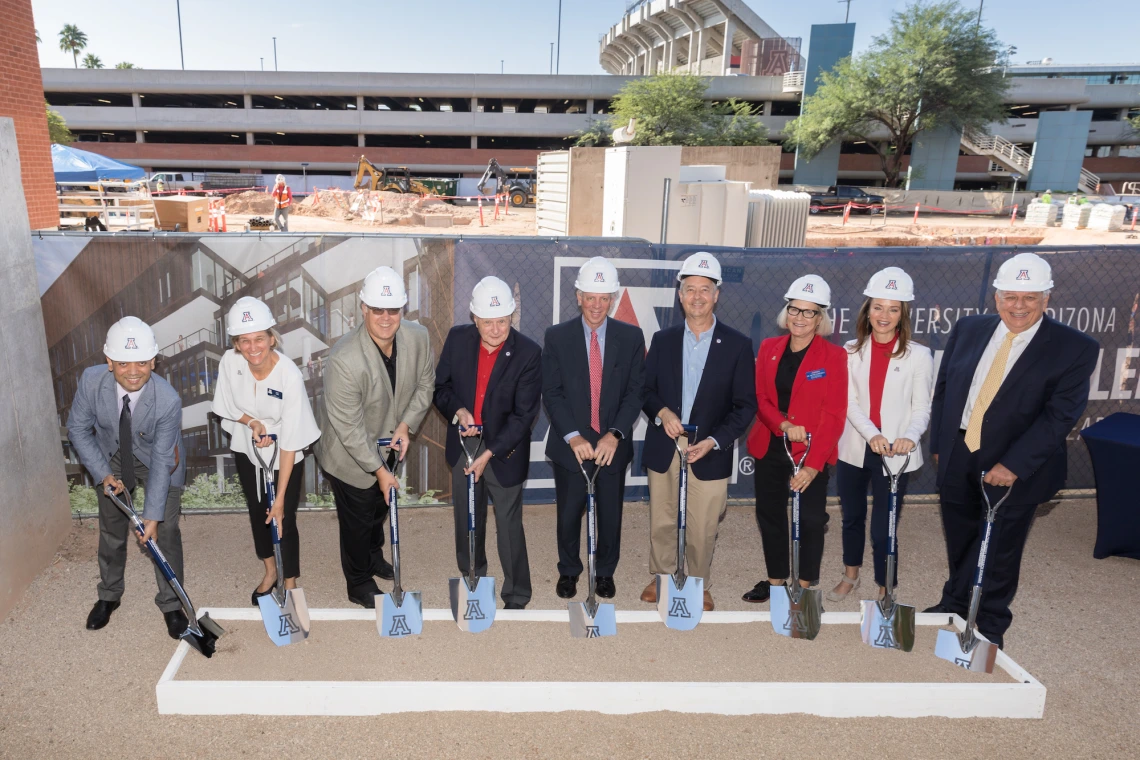Construction Underway on University's Grand Challenges Research Building

Attendees at Tuesday morning's groundbreaking ceremony for the Grand Challenges Research Building. From left: Saikat Guha, professor in the UArizona James C. Wyant College of Optical Sciences and lead investigator of the Center for Quantum Networks; Liesl Folks, university senior vice president for academic affairs and provost; John-Paul Roczniak, president and CEO of the University of Arizona Foundation; James C. Wyant, professor emeritus and founding dean of the Wyant College of Optical Sciences; University of Arizona President Robert C. Robbins; Thomas Koch, dean of the Wyant College of Optical Sciences; Elizabeth "Betsy" Cantwell, UArizona senior vice president for research and innovation; Lisa Rulney, UArizona senior vice president for business affairs and chief financial officer; and Ron Shoopman, member of the Arizona Board of Regents.
Chris Richards/University of Arizona
Construction is underway on the University of Arizona's new $99 million, seven-story Grand Challenges Research Building, which will house laboratories and flexible research space for cross-campus interdisciplinary programs designed to address society's most pressing questions, possibilities and issues as they arise and evolve.

ZGF / BWS Architects
Located on Cherry Avenue between East University Boulevard and East Fourth Street, the nearly 115,000-square-foot facility will connect to the Meinel Optical Sciences Building. The new building is expected to be completed in February 2024.
"Our strategic plan prioritizes building a well-rounded innovation ecosystem, which is one of the ways the University of Arizona is driving the Fourth Industrial Revolution to ensure technological innovation is human-led and human-centered. This building will help us expand our interdisciplinary research capacity in areas such as optics, quantum computing, advanced communications and biomedical technologies," University of Arizona President Robert C. Robbins said during a formal groundbreaking ceremony held Tuesday at the construction site.
The Grand Challenges Research Building, or GCRB, is a key component of the "Grand Challenges" pillar of the university's strategic plan. Those grand challenges fall under areas such as space exploration, artificial intelligence, the environment and disease prevention.
"Every square foot of the Grand Challenges Research Building has been thoughtfully designed to promote the university's culture of collaboration and innovation while imparting up-to-the-minute knowledge and developing cutting-edge technology in optics, quantum information science, advanced communications and biomedical technologies," said Elizabeth "Betsy" Cantwell, UArizona senior vice president for research and innovation.
The GCRB will include a ground floor with public spaces, study spaces and meeting rooms to support student engagement and instruction, as well as three floors of laboratories and offices dedicated to faculty growth in the James C. Wyant College of Optical Sciences.
"The teaching, research and maker spaces in the Grand Challenges Research Building will provide students with abundant opportunities to engage in hands-on learning and cutting-edge research activities during their academic careers. We aim to inspire students and empower faculty by providing a space in which they can innovate and create real-world solutions to address societal challenges," said Liesl Folks, UArizona senior vice president for academic affairs and provost. "It is no surprise that student engagement leads to improved academic success and involvement on campus. The resources provided by the Grand Challenges Research Building will enable new research opportunities for students and faculty alike."
The building also will include three floors dedicated to research laboratories and offices for centers and cross-campus interdisciplinary programs, including the new Center for Quantum Networks, led by the College of Optical Sciences.

In addition to three floors of research labs, the GCRB will include public spaces, study spaces and meeting rooms to support student engagement and instruction.
ZGF / BWS Architects
In August 2020, the university was awarded a five-year, $26 million National Science Foundation grant to establish and lead the Center for Quantum Networks, with an additional five-year $24.6 million option. The center aims to lay the foundations of the quantum internet, which will revolutionize how humankind computes, communicates and senses the world, and places Arizona at the forefront of quantum networking technologies.
Saikat Guha, a professor in the College of Optical Sciences, is the lead investigator of the project, which includes a team of UArizona experts and core partners Yale, Harvard and MIT. In addition to developing the quantum internet, the Center for Quantum Networks is charged with creating the curriculum for the new discipline of quantum information science and engineering.
"The new GCRB will enable the Wyant College of Optical Sciences to expand its leadership and realize our land-grant mission by developing opportunities for optics and photonics to improve our everyday lives," said Thomas Koch, dean of the Wyant College of Optical Sciences.
The GCRB and the James C. Wyant Endowed Chair initiative to support up to 13 new endowed faculty positions in optical sciences are designed to allow for growth in new faculty research and graduating students, and ensure the future talent pipeline in applications that include biomedical instruments, imaging technologies, space exploration, fundamental laser physics, manufacturing, autonomous systems and the future of the internet.
"Philanthropy has always played a role in powering transformational research at the University of Arizona," said John-Paul Roczniak, president and CEO of the University of Arizona Foundation. "The visionary support of Jim Wyant not only funded scholarships and faculty positions within optical sciences, it also inspired many others to join him. This new building signals the university's commitment to solving grand challenges, and we invite our alumni and friends to be part of it through support of the Research Investment Fund. This fund will augment labs and equipment and support junior researchers with seed funding."
ZGF Architects and BWS Architects designed the Grand Challenges Research Building. Kitchell Contractors, Inc. of Arizona is the construction firm for the project and was the contractor for the university's Health Science Innovation Building, a 220,000-square-foot building that opened in 2019.





